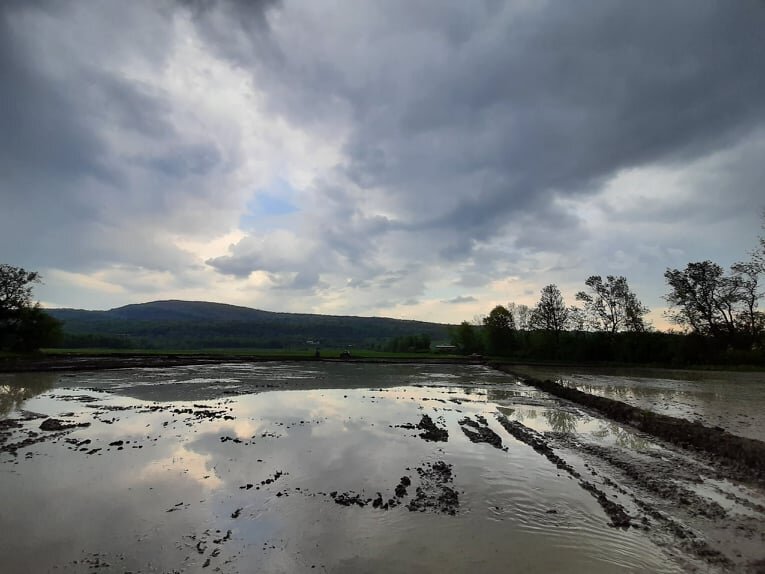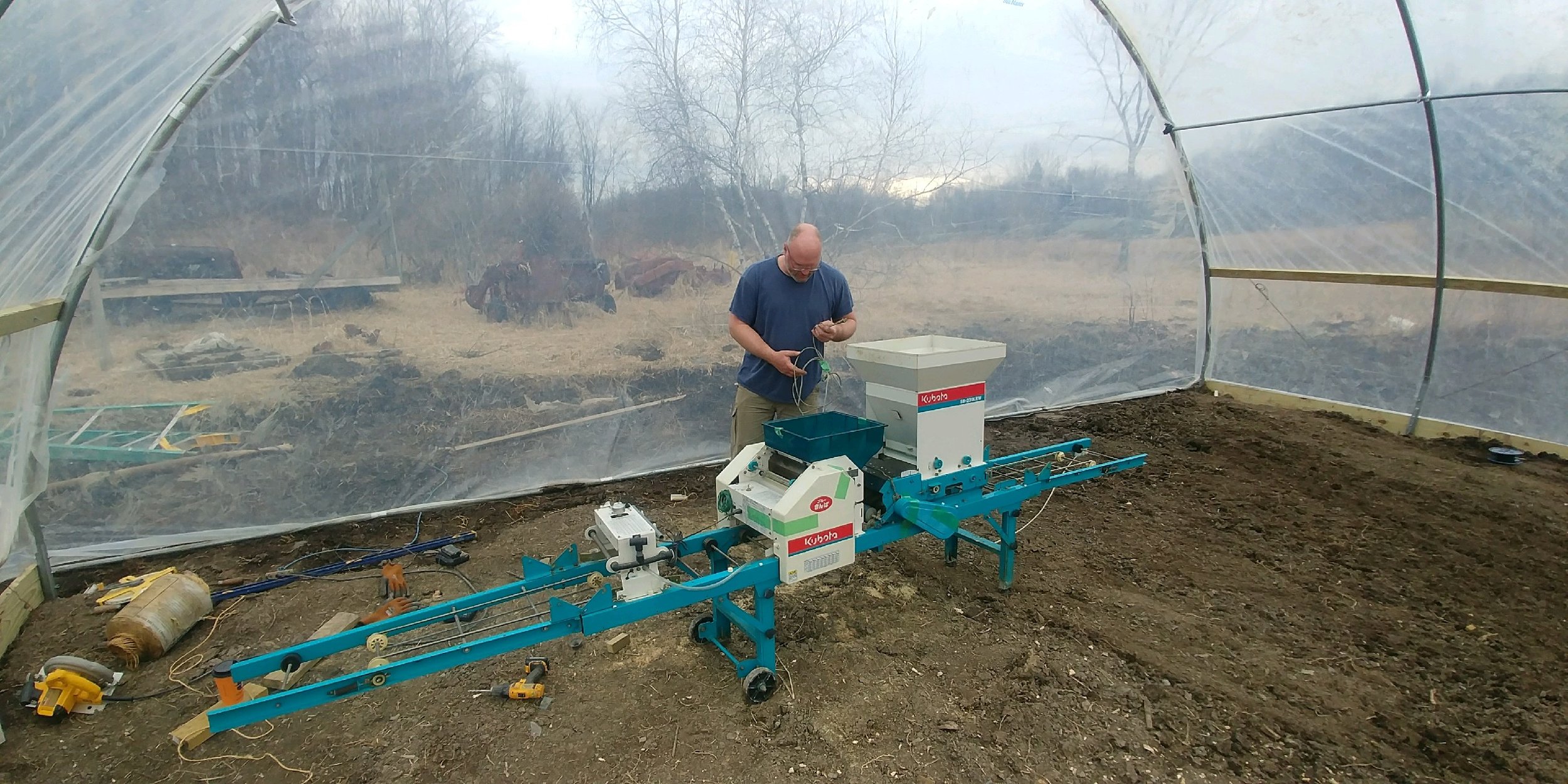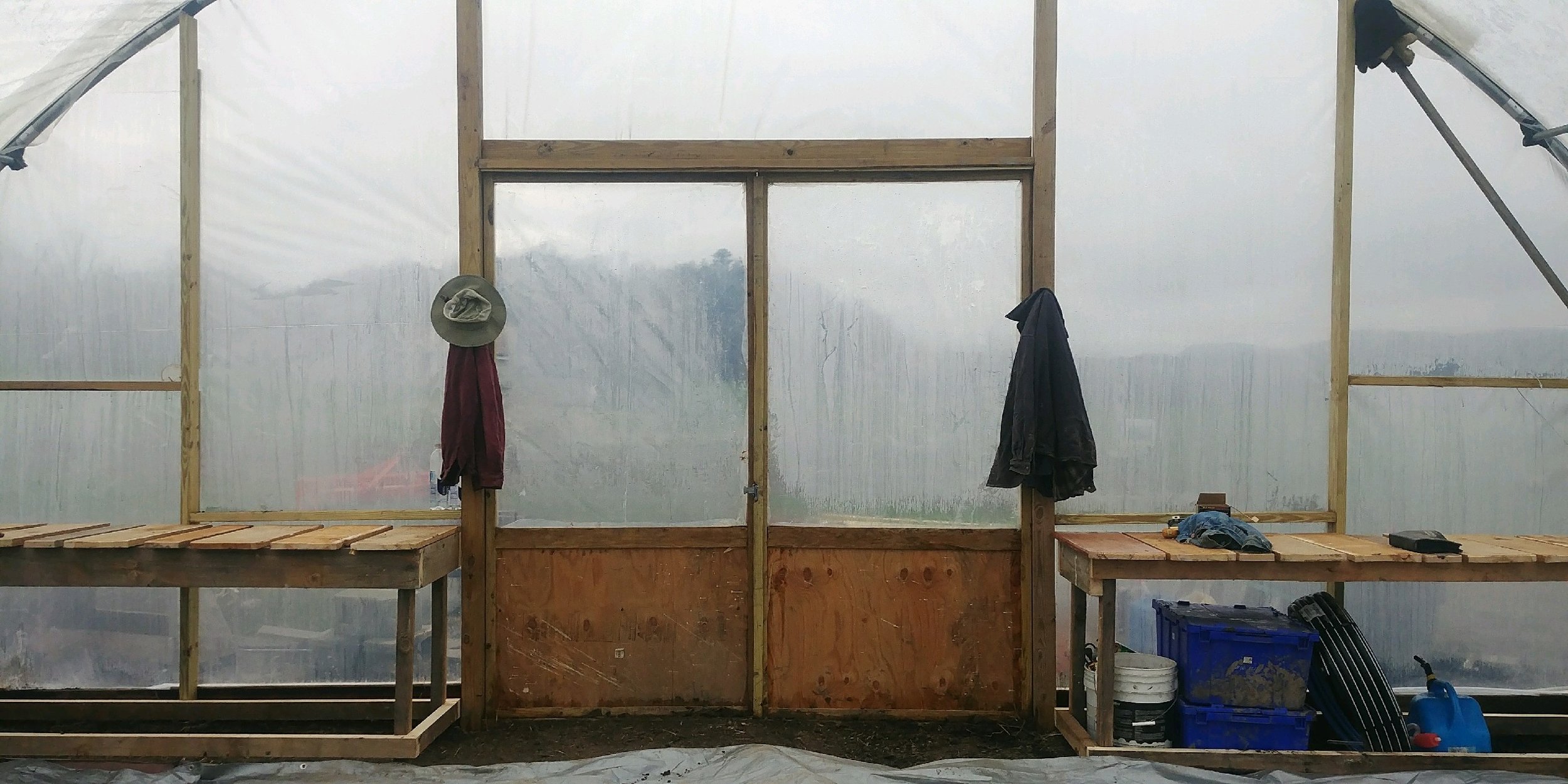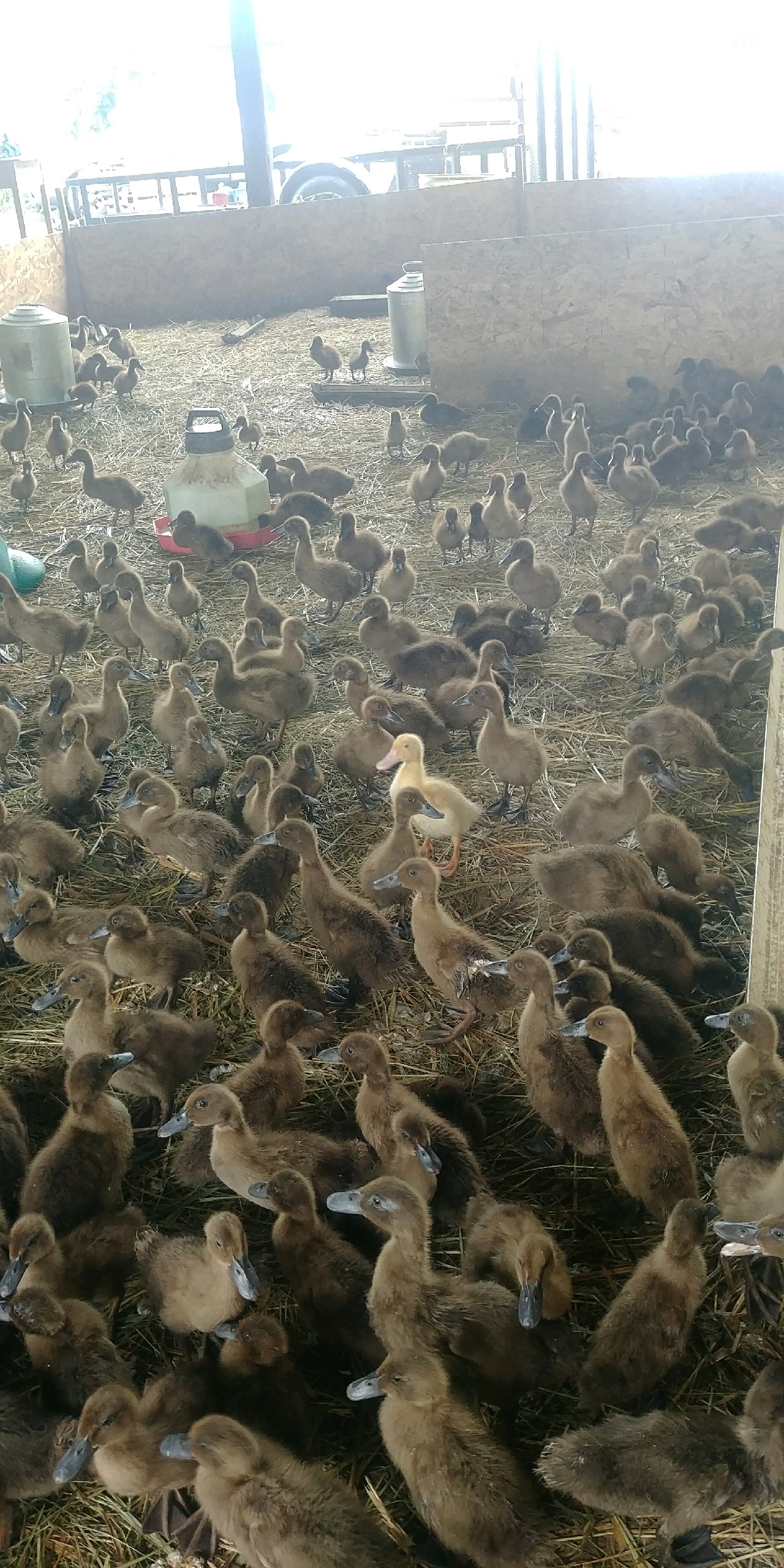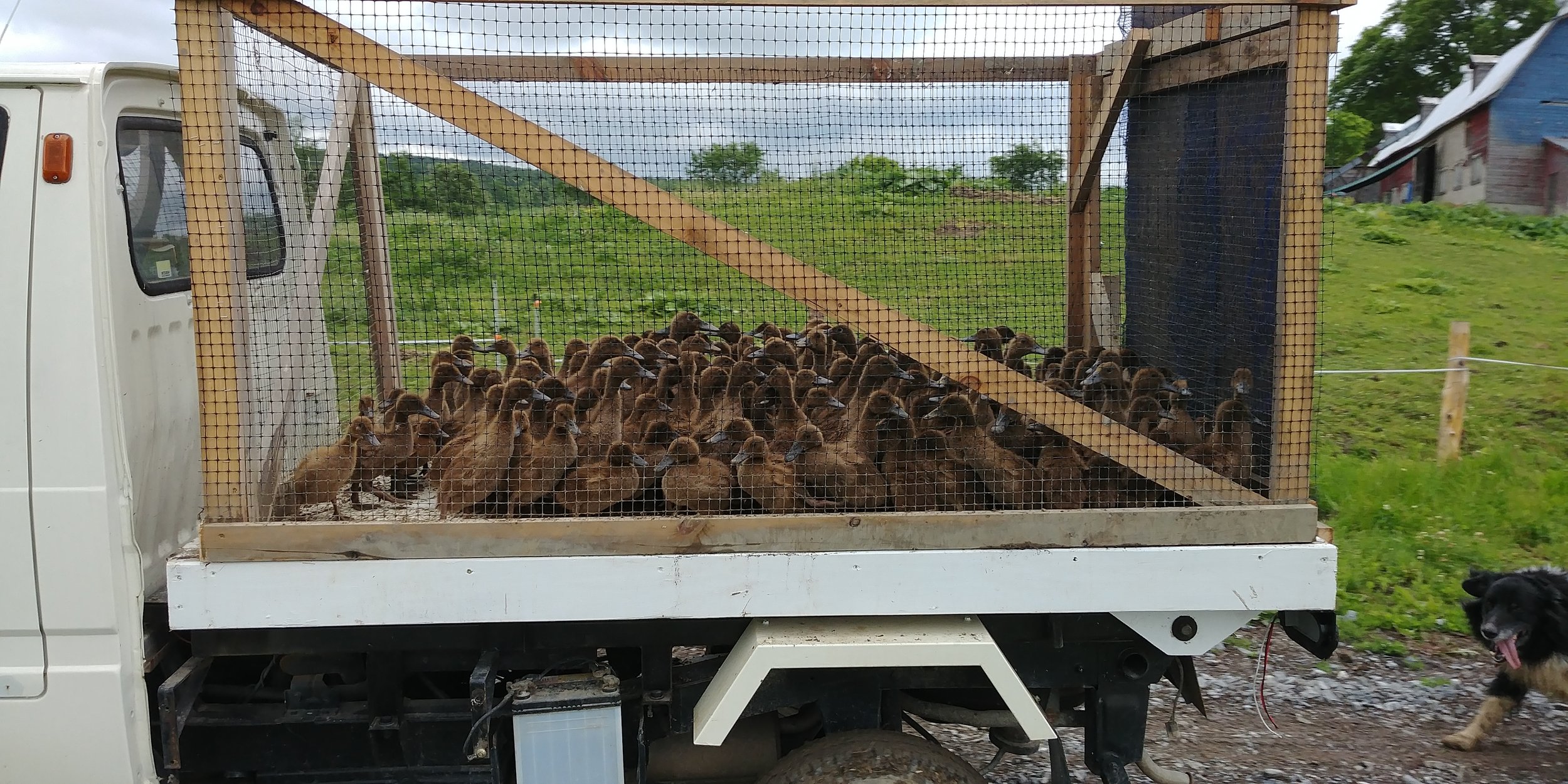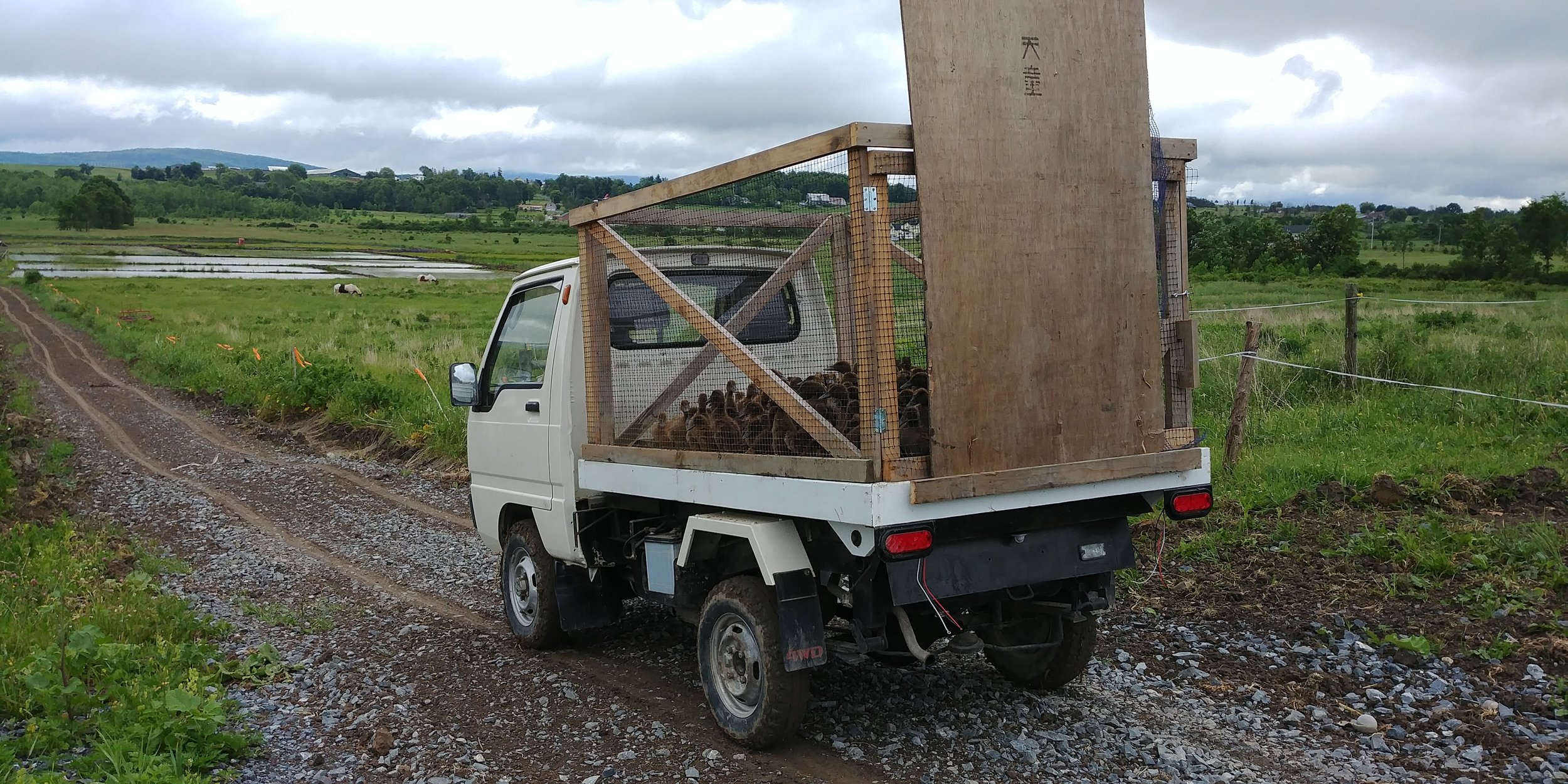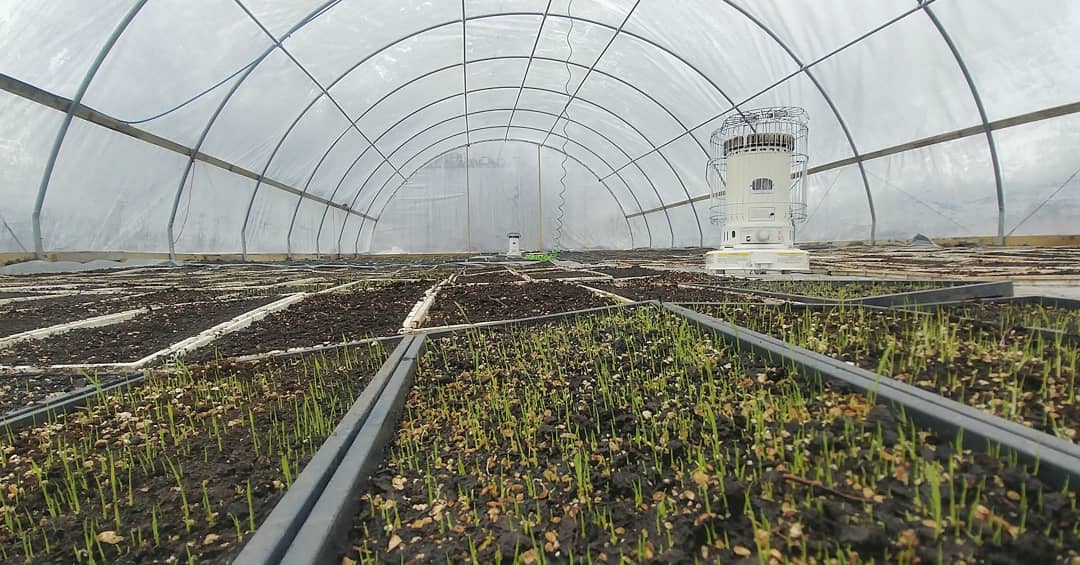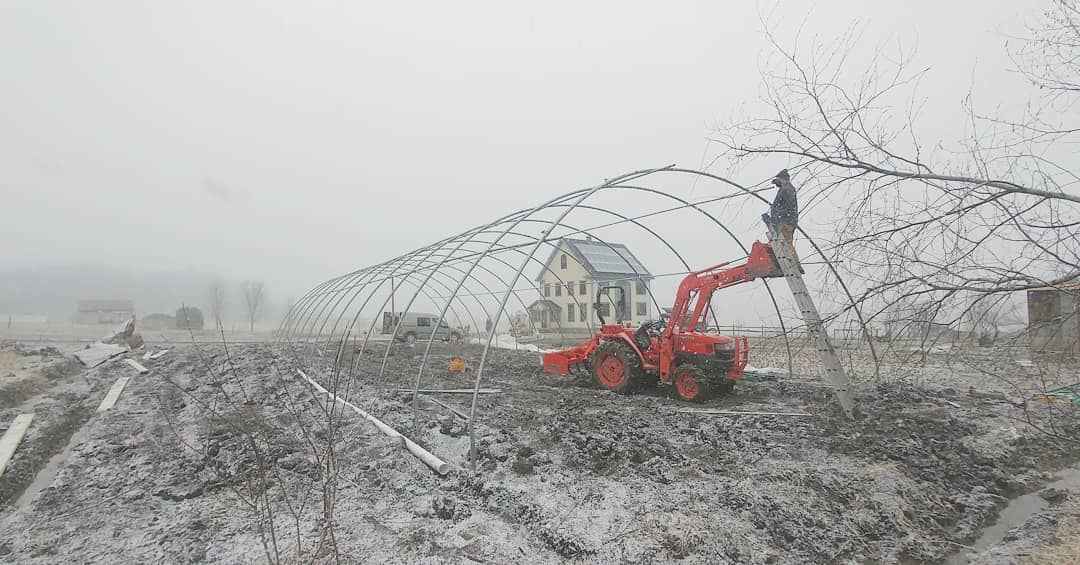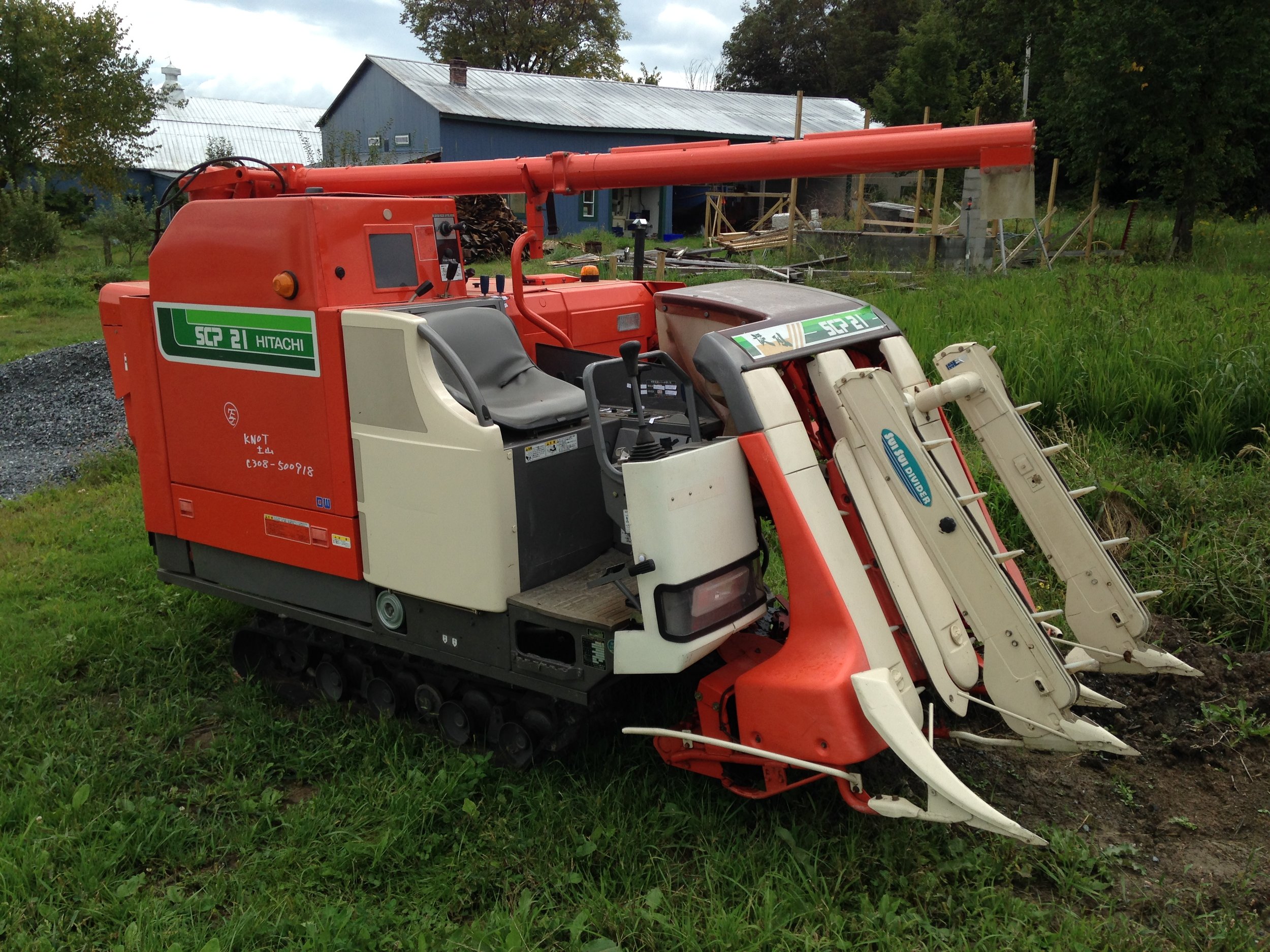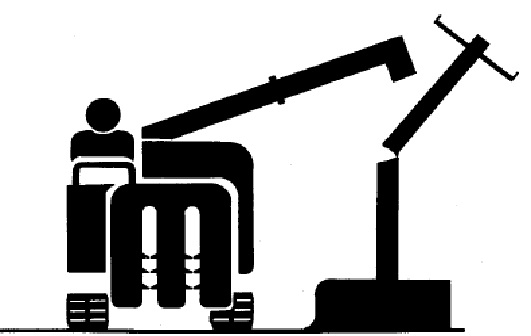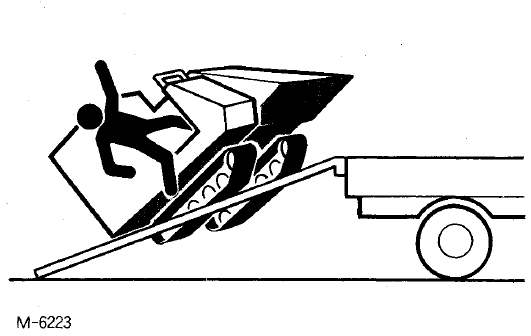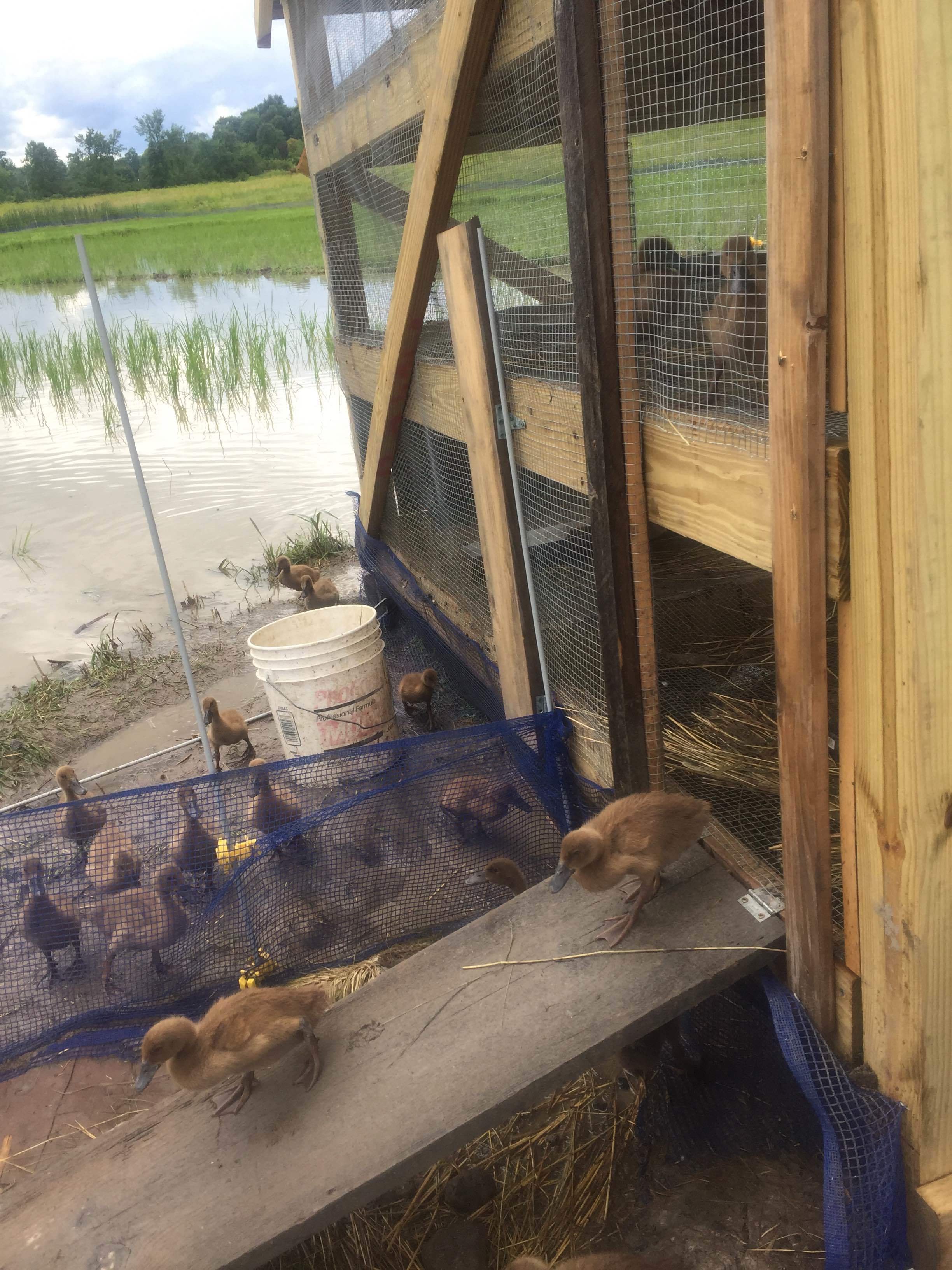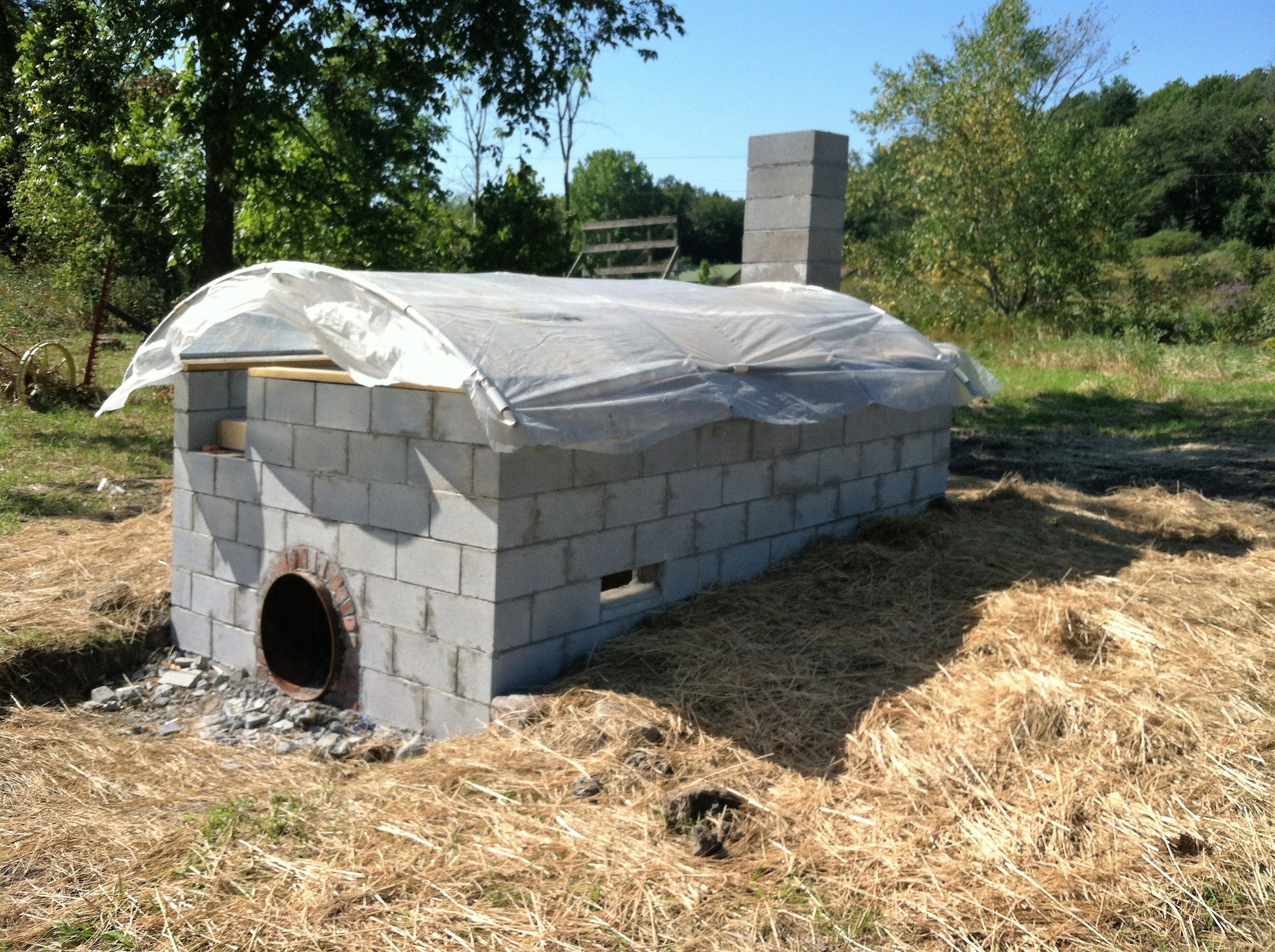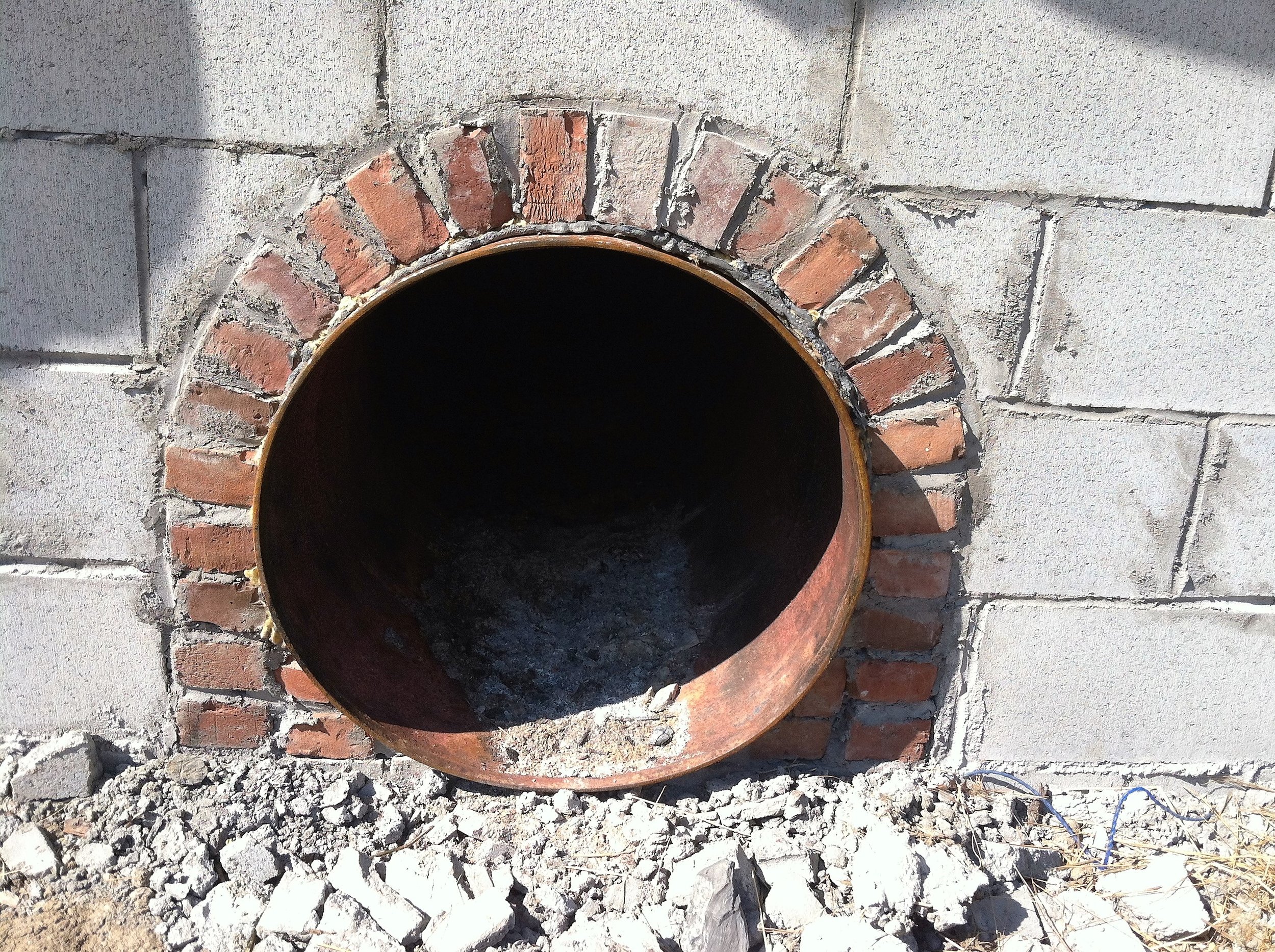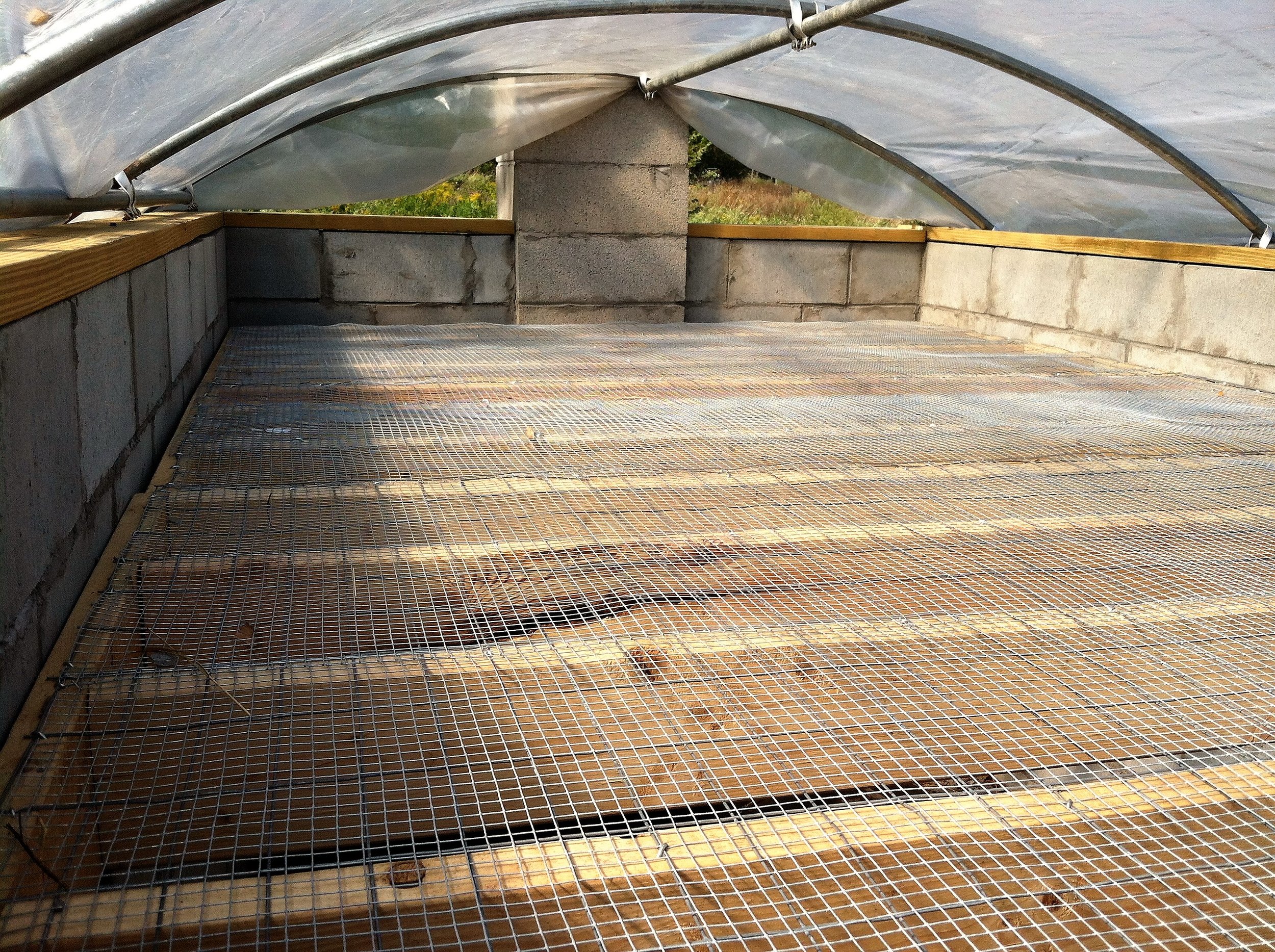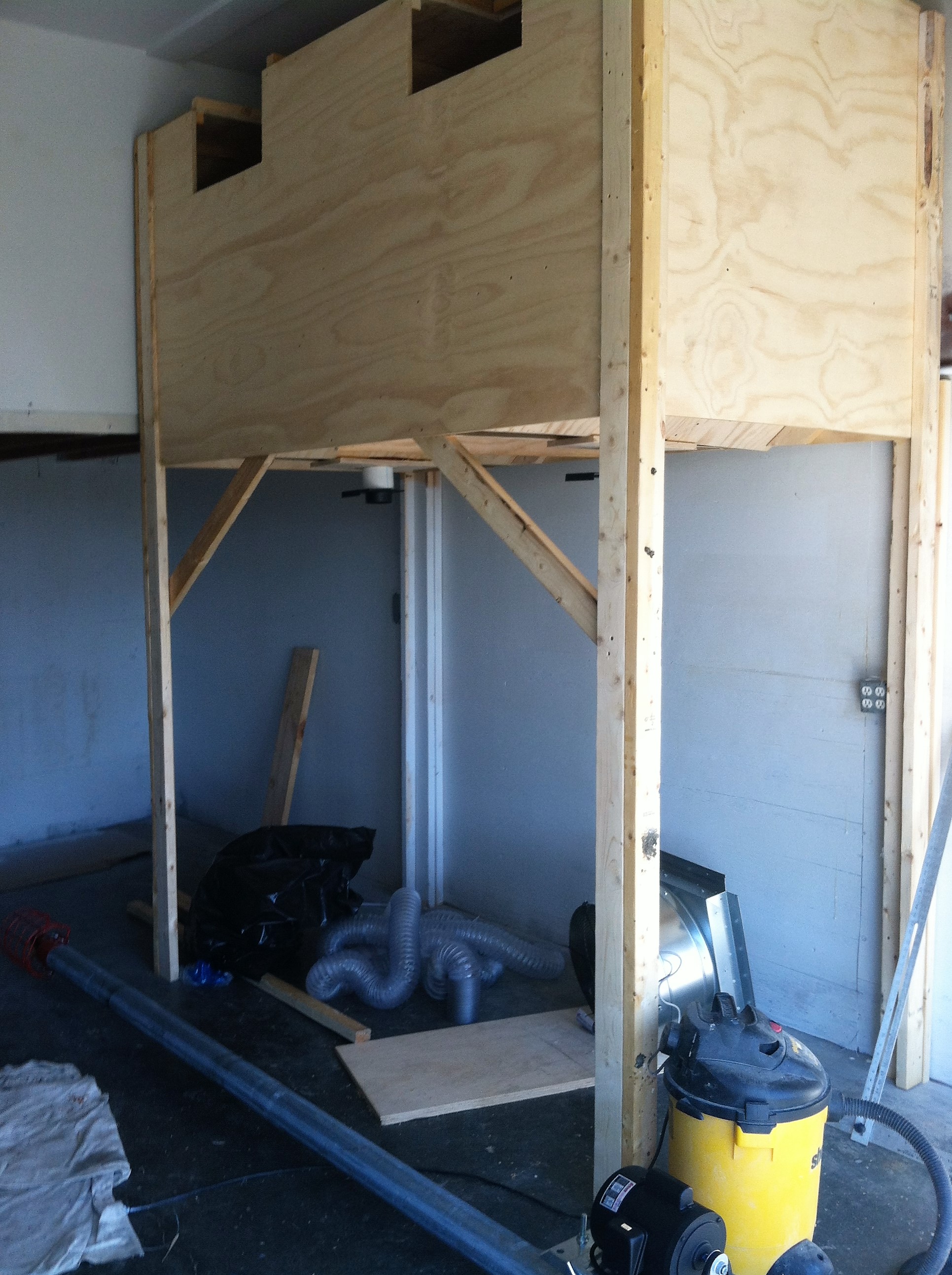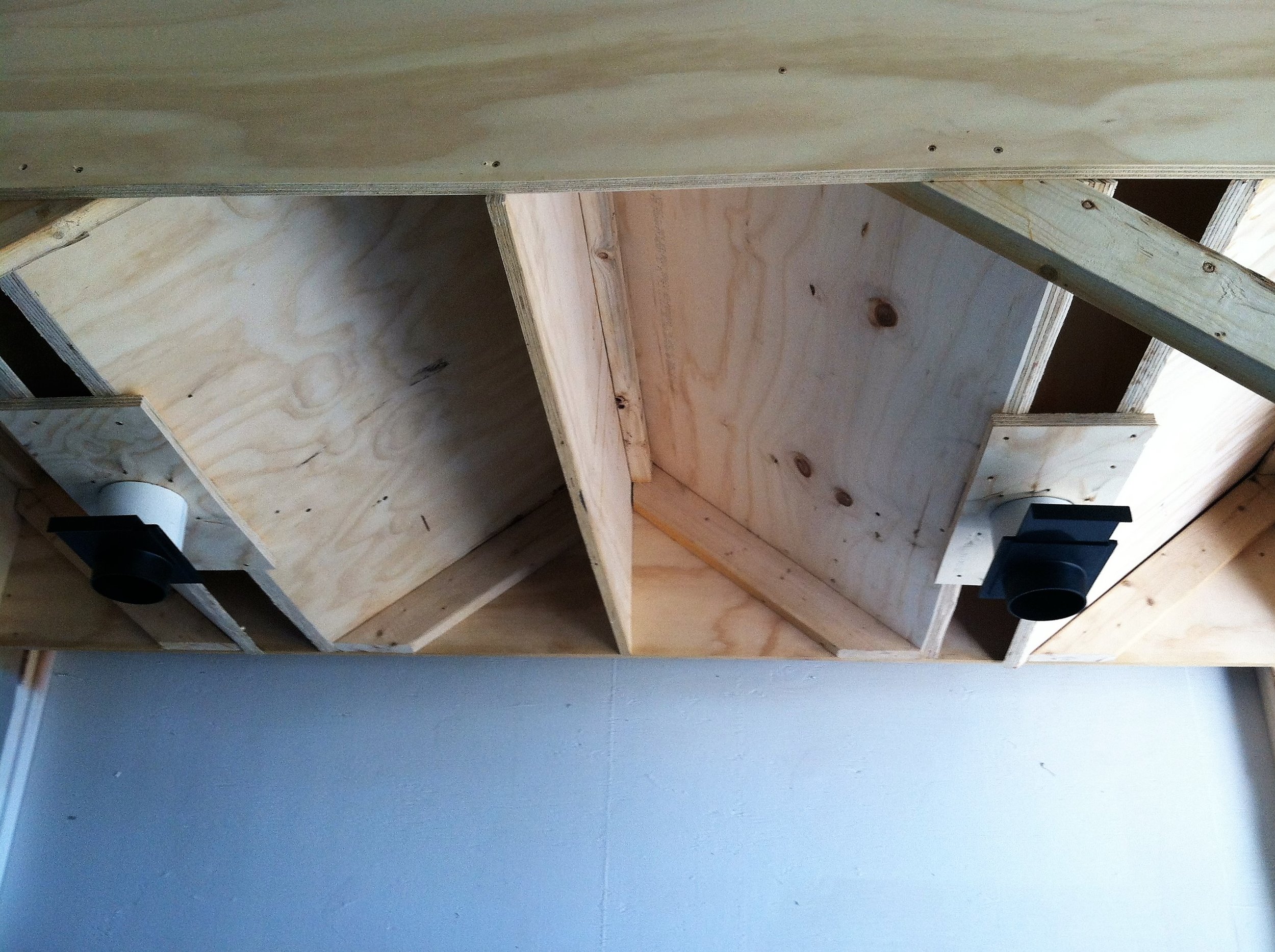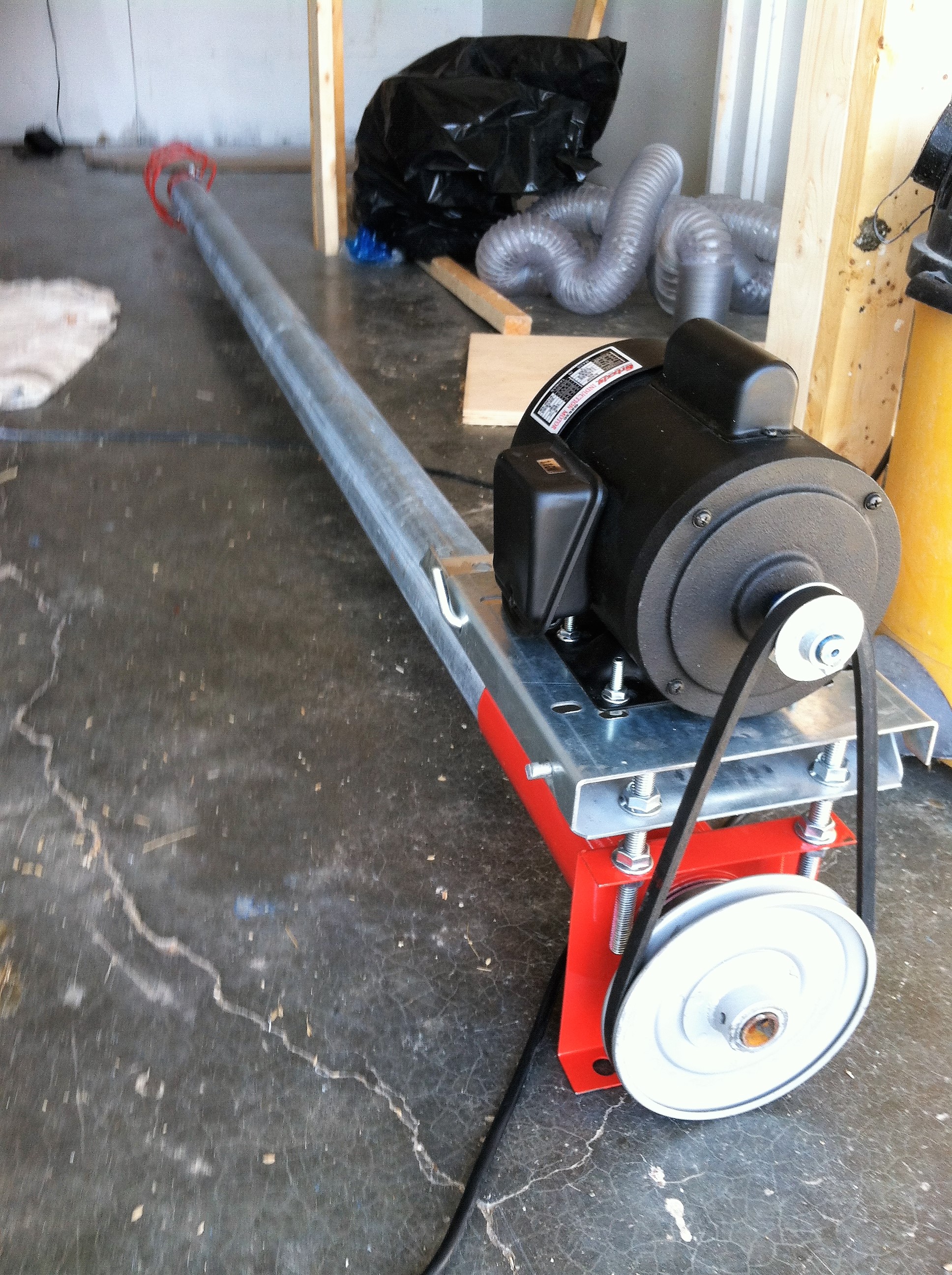
THE LATEST QUACKS
News from the Farm--Same Plan, New Fields
Have you missed us? We missed you. 2020 was a crummy year in a lot of ways. For one thing, the drought cost us nearly all of our rice harvest. That meant a drastic reduction in income for me and no rice for you.
At the heart of the problem was the fact that the piece of land we farm, our home farm, is generally quite wet and soggy but not guaranteed to be so. When we first created the rice project here on Burroughs Farm Road, we tried to work with the tendency of the core of the farm to collect water, and in fact we enhanced this attribute through creation of a reservoir pond of 160,000 cubic feet and berms to retain water. When water runs off over the landscape, generally after a very heavy rainstorm or after a few days of steady rains and showers, a few ditches that drain neighboring lands will fill our pond. If they flow at all, they will generally add several inches of pond depth or even fill it completely, no matter how low it was to begin with, if the storm is a strong one.
Rice seedlings in the greenhouse, lightly misted
The design goal is for the pond to retain enough runoff water see us through the “critical irrigation period” which lasts from mid-May, when we begin to flood and prepare fields, to mid-July, by which time plants are fully rooted and can thus withstand occasional drying. But acute drought during this time can hit us very hard. Our math depends on the pond getting replenished at least once during that 8 week period, because that 160,000 cubic feet can get used up quite fast spread out over five or more acres.
In 2018, water was very tight but we pulled off a good crop. 2020, however, did us in almost completely. Roughly 3 acres of rice withered and died, as we diverted dwindling water reserves to irrigate the best 2 acres . But even then we couldn’t maintain water levels high enough in these fields, and three-quarters of that area was also effectively lost (the ducks can only do so much!). However, one-half acre of rice was saved through a backbreaking campaign of hand weeding in the July heat, ensuring that at least we’d have enough seed to continue, even though the greater part of the season was basically up in smoke. There’s no crop insurance or any other kind of security for this kind of farming. We’re working without a net.
A mini truck full of rice transplants heading off to the paddies!
So, I did not have a great year last year. Therefore if you need another reason to look back in 2020 with distaste you may add this to the list. But farming is an act of eternal optimism. In the bleakest defeat is something to learn and grow from.
Hard as it was to accept, I came to realize that our home farm has unacceptable vulnerabilities that we just can’t correct. So I started to look at neighboring parcels, with a hopes of growing rice there, whether we have the privilege of owning them or not. There are parcels of land here and there in our town and neighboring towns, some much more suitable for rice than the only-somewhat-suitable farm I happened to buy back in 2006. Of course I didn’t know then that I had a future as a rice farmer!
We first planted rice in 2010 at our home farm in tiny hand-dug paddies and harvested 20 pounds our first year. We’ve had good years and bad, but even the bad years left me with some lesson about how I could improve and avoid pitfalls. Time and again I have doubled down on this idea of growing rice in the Green Mountain State. Over 10 years in, with so much hard-won experience gained I couldn’t allow myself to quit, though it’d be dishonest to say the idea did not cross my mind. One advantage I had as I sought a new plot was that the experience of field engineering here over many years had taught me exactly what land characteristics you need to create the best possible rice plot for the least effort. Eventually, I found a plot that met my criteria.
And so I signed a lease with a local landowner early this year and my new helper, Tess Clarkin and I surveyed the land and established a brand new rice paddy system on the banks of Little Otter Creek in New Haven, Vermont, 10 minutes drive down the road. It’s a little odd commuting to work rather than just walking out the back door, but I guess I’ve gotten used to it. We have a state water permit that allows us to draw from the river, which even at the lowest possible levels, can support our few acres of rice, so no reservoir is needed here. When the wind is still you can hear the water gurgling through the channel. It’s a great comfort.
Rice transplants starting to grow, grow, grow in the paddies!
Even better is the fact that the riverine soils of our new plot have a fertility edge over our soils at home, and we get to share our work environment with the river wildlife, including snowy egrets, great blue herons, night herons and wood ducks!
I won’t lie, it’s been an insane amount of work. Long hours, endless breakdowns, vehicles stuck in mud. Well, I guess all that is pretty usual. You have to be a bit different to love this kind of job. But love it we do.
Now we’re just weeks out from bringing the crop home. I can’t wait to share it with you.
A full, beautiful set of rice panicles.
Rice Harvest Coming Up!
Rice is plumping and ripening up out in the fields. We’re now about 3 weeks out from bringing it in. This is actually our ninth year (!) harvesting rice and I can almost say that we are becoming somewhat competent at it.
For a farmer who aims to make a living from growing a grain crop, which I do, approaching harvest is a time of tremendous anticipation, anxiety, excitement. The work itself is lively and fun (at least when there is no crisis or breakdown) and at the end of it there is a concrete accomplishment, measurable by the fifty pound bag or by the ton. Only then will we know exactly how close we’ve come to reaching our productivity goals.
Naturally, on a multispecies integrated farm production isn’t our only goal. We want to improve the landscape and soil to manage water more easily and to build soil fertility, and to build a business model that is personally, socially, and environmentally sustainable in every way possible. If we can do this and create habitat along the way for various creatures that come to call or come to live in our rice project, that’s also a plus.
Looking back, we started harvesting rice with sickles and threshing by hand, and then with a 1930’s thresher. Then we got a rice combine and some rice hulling equipment from China. That rice combine was rickety and loud and would easily get stuck in any soft spot in the field. Also, it harvested the rice into bags which had to be tied, then lifted and carried several times.
Our older Chinese rice combine. Three wheels of craziness!
A real turning point was when we finally were able to acquire Japanese equipment, including a modern combine, gravity wagon, dryer, and huller. Every one of these items except for the huller has some sort of domestic American machinery analog, but the Japanese items are much cheaper, much better, and always sized for the correct scale of operations. The only downside is that they are documented and labeled in Japanese and spare parts are a long way away.
Using the same kit of tools as a small rice farm in Japan would use, we have begun to get a grip on the process, which is good, because if our harvesting and drying methods hadn’t kept up with field production our old way of doing things would simply not be able to keep up. I still don’t think our execution is going to be as sharp as a typical farm in Japan, but we’re getting closer!
Last weekend the farm and bakery were the first stop on the Addison County Tour de Farms bike tour hosted by Acorn. While unfortunately we weren’t able to sample any rice, we were be able to show off some of our cool machines and to sign people up for rice preorders and we had roasting ducks for sale on the spot and plenty of pastries and bread available. Also our fruit trees have given us a good year so we had some nice plums on offer too.
Reaching the Goal
My name is Rachel and I am the 2018 summer intern at Boundbrook Farm. I am about to start my junior year at The University of Vermont in pursuit of my Food Systems degree. As a Food Systems major, I learn a lot about the challenges and benefits of sustainable agriculture, and wanted my own personal experience of growing food this summer. I was drawn to the unique integration of rice and duck farming at Boundbrook Farm - who wouldn’t want to spend their summer singing to ducklings? However, I quickly learned on my first day that running a rice farm is much more work than just splashing around in the paddies with ducks.
The most important thing I have learned from this internship so far is how much we take food for granted. For most people, when we go to the grocery store, we are attracted to the bright and nifty packaging, and the convenience of easily prepared foods. We push our carts down the aisles complaining about the price of produce trying to find something that our families will eat. However, before starting this internship I had never taken the time to sit back, look at my food, and really think, where did it come from?
Someone worked really hard to grow that lettuce that sits perfectly under my hamburger bun. Someone else worked really hard to raise the chickens that laid the eggs I had in my omelet. And that rice that is packed so perfectly into that tiny little sushi roll? Someone worked really, really hard to grow that rice.
Working on the farm has been a test of endurance both physically and mentally. My spine cringes every time I hear the words “hand transplanting rice” in anticipation of spending the next few hours crouched over. The blisters and bruises on my hands along with my dirt-stained fingernails scream that I work on a farm. But my body has gotten stronger. My skin is tanner. I have a new level of physical endurance that cannot be reached on a treadmill, but most importantly my knowledge of our food system has greatly expanded.
While I may never use a rice transplanter again, I know that I have the ability to quickly learn how to use new tools and machinery. I now understand how the changing climate impacts the way we grow food. Since the pond dried up in the unforgiving heat this summer, we had to use water from the town to avoid crop failure. Each day there are new sets of goals that are commonly interrupted by challenges that are out of our control. Our job as farmers is to solve these challenges as smoothly as possible relying on science, experience, and a whole lot of trial and error.
However, our job is not to just solve these problems so that people can eat. Our job is to provide people with food in a way that is sustainable, so that future generations are able to continue this process that we have worked so hard to figure out. That is what makes Boundbrook Farm unique. We work with the natural system that is already in place and use it to our advantage, instead of manipulating the environment to fit a synthetic system.
So the next time you eat a meal look at its components and think about where they came from. How were they grown? Who grew them? How far did they travel to reach your plate? Really question where your food comes from so that the next time you go to buy food you are also working hard to reach a more sustainable food system.
Summer 2018 - Drought Tests the Limits of the System!
The bottom of a drainage ditch usually full of water.
I kind of got into rice farming based on observation and intuition. Clearly, my land wanted to be a wetland. Over the years prior to my coming here, past farmers had made various changes to thwart this tendency. But the basic topography, which is a flat plain covered with heavy clay soils, just wants to hold onto its water most of the time. Even when tiles are buried and drainage ditches dug, they tend to be filled in fairly quickly with sloughing clay mud, as the land works back towards what it was before European-style agriculture came here -- a wetland.
Having seen a rice farming culture at work in Japan, I decided to apply a version of that to my land here. And generally, rice farming has proved to be a pretty great fit for this otherwise difficult-to-love parcel of New England farmland. Rather than curse the clay as we Addison County farmers often do, rice farming helped me to learn to love it.
Even the storms that increasingly define our summer rainfall here don't cause worry to the rice farm. In fact, they help to quickly recharge the storage pond, ensuring that I have adequate irrigation water throughout the early summer. And a cloudburst of an inch or two of rainfall merely means that water in the paddies is raised by so many inches, until any excess drains back into storage ponds. I never have to worry about erosion or anything like that.
This year though, there has been some worry. While elsewhere in the state there's been adequate rain, here in Ferrisburgh we are abnormally dry. Since late May there have been enough showers to periodically wet the surface of the soil, but never enough rain to result in runoff. Every ditch and small stream in our area has dried up. Our normal rainfall for June is 3.5 inches or so, but we've only received about 1", and the month is nearly over. All this has pushed our system, which is based on surface water collection and retention, to the utmost limit.
Our pond, which holds around 200,000 cubic feet, or about 1.5 million gallons, is down to the last 5% or 10%, with some worried fish . The rice in the field looks great...for now...perhaps the best ever.. but without adequate water to suppress weed growth in the coming weeks, the season is on the edge of a knife.
In past years, our storage pond has always sufficed. Sometimes we have pumped the water level down pretty far...but never this far! And with no serious rain in the forecast, at least not for sure, we are now making the unprecedented move of piping metered town water down to the fields to help maintain our water levels wherever critically needed. Hopefully that modest water input will help us hold things together until we start getting rain closer to our normal averages.
And, in the silver lining department, we can at least use the opportunity of low water to enhance our pond and canals. We now have a small excavator on the farm, which has allowed us to make great strides towards the Japanese-style infrastructure I have been coveting since visiting rice farms there in 2015--featuring narrow roads criscrossing the project that are driveable with a tractor or minitruck, and crisp, uniform ditches and berms.
This year's crew includes Rachel Shannon, a Food Systems major from UVM, and Andon Whitehorn, a trained sushi chef and understudy partner rice farmer. We've been pushing ahead despite the water challenges.
Generally, I'm still confident that the system is well designed and we're simply in a weird year, facing drought at the worst possible time for our operations yet doing okay. We're doing our best to make sure that both water collection and water storage are upgraded in time for next year.
The reservoir pond...lowest it's ever been since we began growing rice here.
2017 Harvest
We're now well into the harvest season. Things are going pretty well so far, but there is of course a period of adjustment with so much new equipment this year. Each item has added a lot to the efficiency and capacity of the operation but has presented its own unique challenges.
The combine is a crawler combine, with rubber tracks (in Japanese, "ku-ro-ra" = "crawler"). As with all the other stuff, the controls are all in Japanese. In normal field conditions, I have to say it does an excellent job and is a breeze to operate. However it does have a tendency to get its pickup apparatus clogged with weeds when it enters a weedy patch, meaning I have to get off and pull the grassy material out of its jaws one handful at a time.
Also my hopes that it would be able to harvest even in mucky conditions are a bit dashed as I entered a soft field and could not work it. At least I was able to drive out of it, but we may be hard pressed to recover the rice in this field that still has not dried off after such a long spell without rain. Now more rain is expected towards the end of this week, so it may have to be hand harvested. Not looking forward to that.
One fantastic feature of the combine is the auger, that empties its hopper into a transport carrier. Normally the transport carrier would be in the bed of a truck, but we carry ours on the back of our tractor. I am still wary of filling the transport carrier to capacity because it could make the front wheels go up in the air. So, with partial loads, the grain is making its way up the hill.
just-harvested rice!
Last year we built a wood-fired grain dryer. So far this year that one has not been used at all, and the new Oshima dryer has been doing all the work. It runs on a program, firing a burner, moving the rice around and blowing air over the whole batch, working through both night and day in a way that I cannot. Although I still don't understand its controls 100%, it is working out really well and getting the rice dried down to milling moisture content really quickly.
The milling part of the process we haven't quite gotten to yet. So far the huller I have been testing has clogged up a few times, but I think it may have been running backwards! There seems to be a polarity issue with the wiring that can be corrected pretty easily. It is all part of the learning process.
trying to make sense of the rice dryer control panel...
As for the rice, it's looking great and there is a lot of it. Advance orders will be available for general pickup two weeks from now, and if you've placed an advance order through the site you'll be hearing from me. I'm also going to reopen the preorder store for a November pickup date.
Enjoy this beautiful fall weather!
Gearing up for Harvest
This year is the first one in which every one of our 5.5 acres was transplanted into rice. We have eleven small plots, averaging about a half acre each. Not all of those plots came out perfectly--some had issues with excessive depth or shallowness that led to poor plant performance or weed growth--but on the whole I think it's realistic to expect our largest harvest to date. But it's not over until it's over!
We have acquired a number of new gadgets to help up with harvest this year. This being our seventh season growing rice, we've had various different kinds of specialized machines for a while, but this year I took the step of importing an entire shipping container of used Japanese rice farming machines and tools. Some of them went to work right away for transplanting, and others are just about to be put to work.
The typical machine process for harvesting includes harvesting with a combine harvester, that cuts the crop off of the soil and separates seeds from leaves and stems as it rolls along. Our previous combine harvested into bags, that would fill with 60-80 lbs of rice within a couple of minutes, requiring the operator to stop and put on a new bag. Our new harvester is a little more sophisticated!
It is an SCP-21, with a fairly modest-sized diesel engine, and it harvests about four feet of width. Arguably its three best features are that it has rubber tracks (meaning that wet fields won't prevent us from getting the harvest in), that it has a grain tank that holds over 1000 lbs of grain (I don't actually know how much exactly) and that it has a built in auger to empty itself into a nearby transport vehicle. It is a 1998 model, yet has only 260 hours of use, meaning that it was used for just a couple of shortish work days each year for almost 20 years. I couldn't get a more recent model due to EPA restrictions, but this one is in incredible condition for its age, and I'm hopeful that we'll be able to use it for many years to come.
Next up is the rice dryer, an Oshima "Royal Temper." As in, "The queen was in a royal temper, " I guess. There is no accounting for the names products are given in Japan, you just have to go with it.
In any event, the Oshima dryer is automated and combines the ability to recirculate the crop with forced air and kerosene-fired heat to expeditiously dry grain. Unlike my wood fired dryer, this one will work through the night. When we bring in the crop the moisture is generally in the 22% range, considerably too high for storage. Expeditious and thorough drying down to a safe level of 14% is pretty critical to quality. And of course the drying arm of the operation has to keep up with the harvesting arm!
Next we have a new huller, which will hopefully solve our brown rice purity problem once and for all. In the past we have struggled to eliminate all unhulled rice seeds from the finished brown rice product we offer for sale. But the Japanese rice hullers have a built-in gravity table specifically to address this issue. So I'm very hopeful, but I won't actually know until we begin using it in earnest.
Learning to use all this stuff being mostly illiterate in the language of their country of origin is a little challenging and I rely on machinery common sense, help from friends, and trial and error. Yesterday Michiko Oishi, capable bilignual person and affiliate of the Vermont Japan-America Society, came by and between us we were able to figure out quite a few labels and functions. And, afterwards, Michiko was able to find an online manual for the combine, which has these helpful suggestions:
Meanwhile, I figured out how to make an ominous beeping alarm turn off on the combine (turns out it was an alert that the throttle is below operating range), and troubleshoot a loud banging noise coming from the dryer (lid was ajar and hitting a moving part).
While all this is going on, the ducks are being fed in the barn and will be available as roasting ducks very shortly. We'll have lots, they'll be going for around $15 each.
Also, the crop is ripening in the field. There is still quite a lot of green down there, so it wouldn't be too surprising if we are starting around the same time of year as last year. We look for about 90% of the rice on the stalks to be brownish in color, and the stalks themselves are usually turning gold as well. Looks like we're still 2-3 weeks out from that all happening.
If this is the case, we'd still be on target to offer up the first new rice by mid-October. I will leave the pre-order system open until at least September 25th. I am also re-applying to attend Burlington Farmers' Market this winter, as I did last year.
Duck Release and Safekeeping
By Elise Schumacher; UVM Next Generation Food Systems Internship Program
Life at Boundbrook has maintained a steady, busy pace since transplanting began in June!
I am proud to say that we have successfully finished transplanting as many rice plants as possible into the paddy. This was a task that proved daunting at times. Broken parts, thick mud, and shallow water levels all offered their own challenges. The paddy is full of healthy plants now, which is a beautiful sight to savor when we take lunch on the back porch!
All the ducklings arrived safely, too. After spending a few weeks indoors to let them grow (and to allow us to finish prepping the fence) we released them into the paddy! It has easily been my favorite moment of the season. Each individual duckling went through their own process of fear and curiosity before diving off the ramp. After contact with the water, a shared sense of delight swelled through the flock as they explored their new aquatic home.

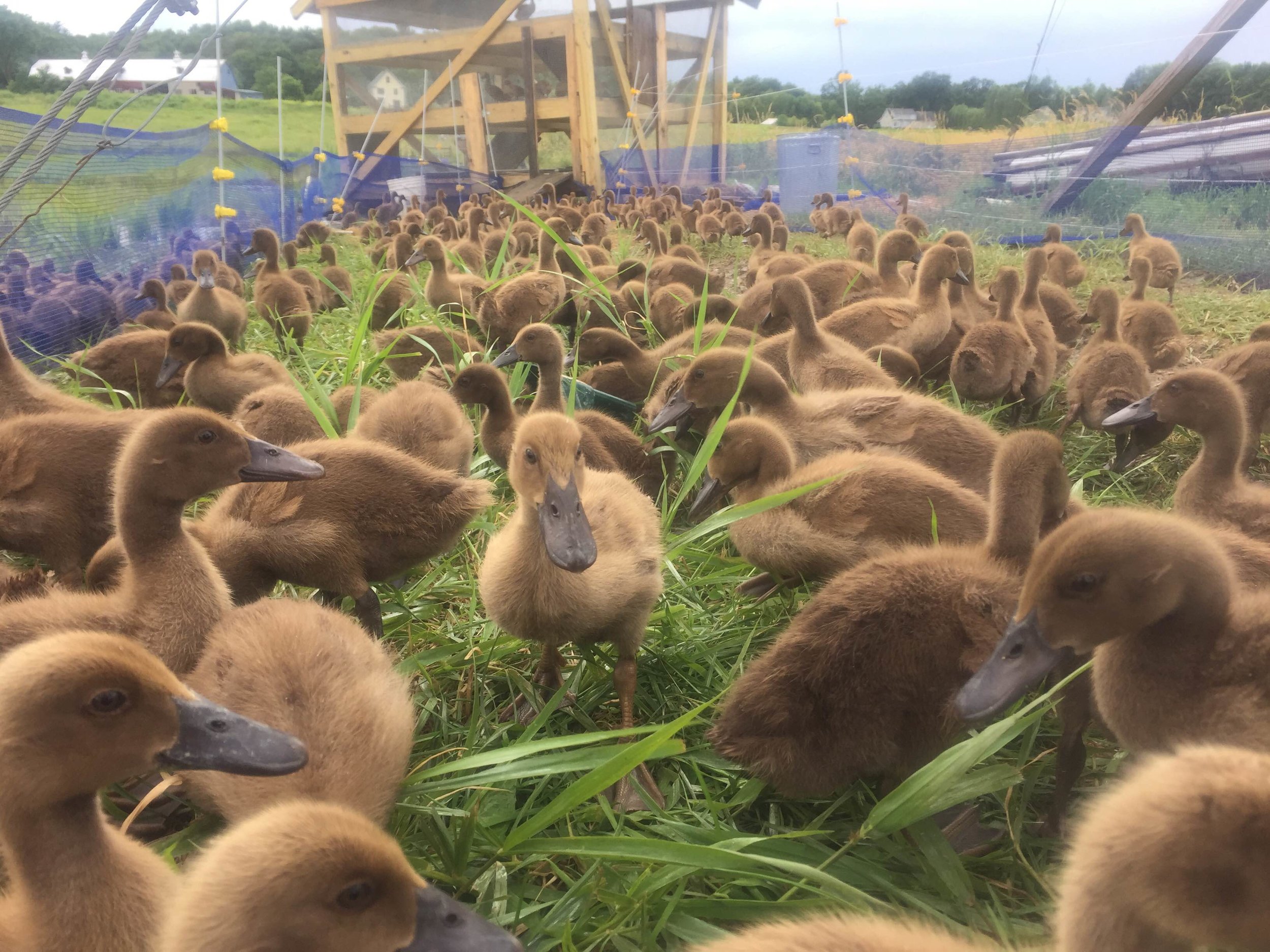
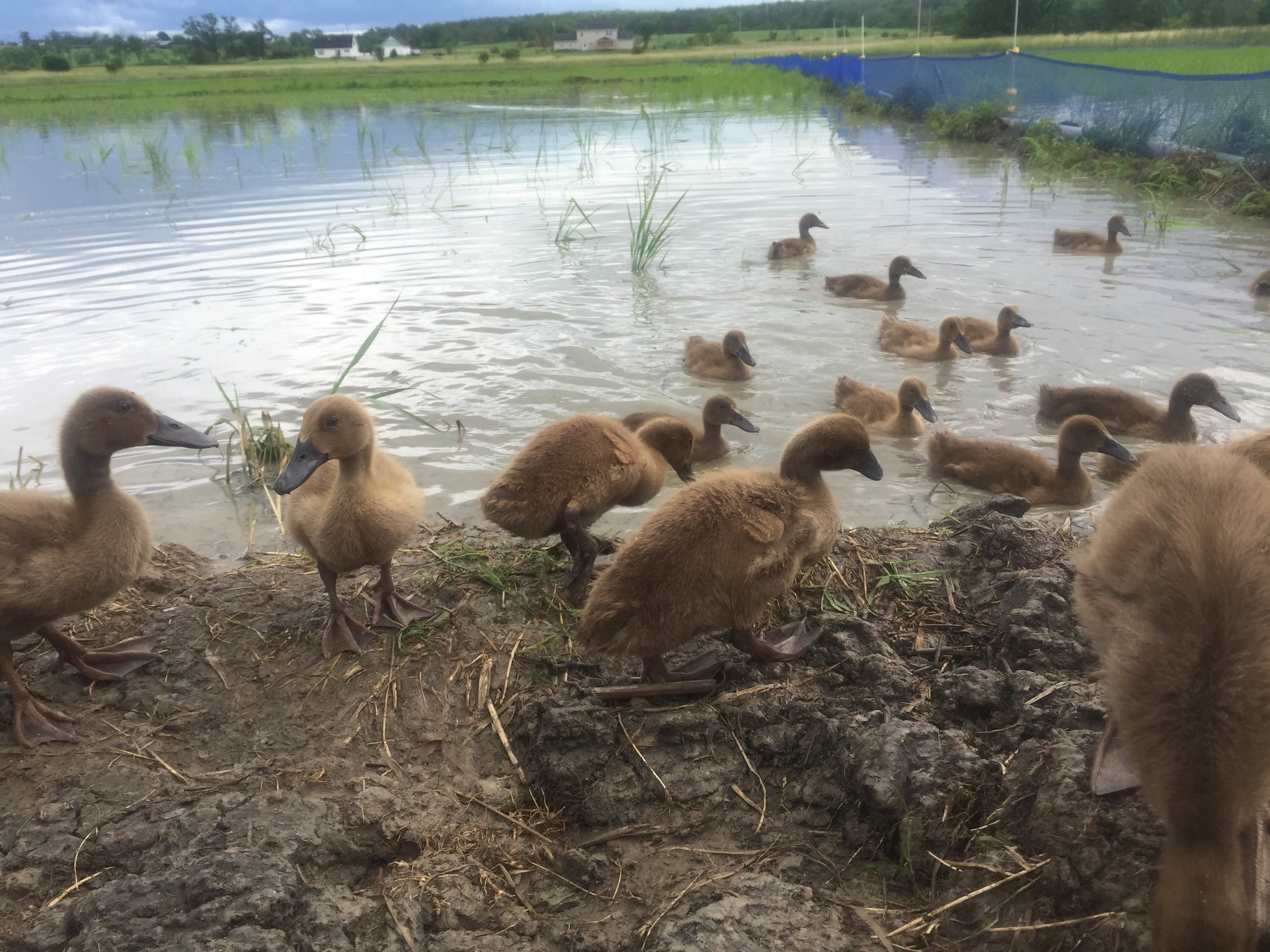
We are just finishing up the fencing this week. With 5.3 acres, this job has been much more time consuming than previous seasons. Duck safety on the paddy is a constant source of concern. Predators typically decrease the flock size by about half.
To address this, a new project we have been tackling this year is a duck house! With Erik's carpentry skills, three us of were able to erect a duck housing structure (or hotel, known as The Billton) with multiple levels in only a number of days. The structure allows the ducks safe haven from predators that typically grab a late night snack.
Transplanting
This is a big year in the development of our rice project. For the first time this year, we are planting all 11 plots, comprising 5.3 acres in total, in rice.
Always there is some limiting factor, somewhere in the process. Initially, it was lack of seed. At other times, our own ignorance of the best methods or the lack of some particular tool was holding us back. However we have a fair amount of suitable rice land and ample surface waters to grow into. Eventually I think the operation might level out at around 10 acres, which feels like a good size to aim for.
When my friend Judd Markowski and I first engineered our rice paddies in 2012, we aimed high and created a total of around 5.3 acres of fields, with the intent to work up to that scale. But only this year will all of those original fields be planted. Some fields still have serious issues, ragged division dikes, high areas within the fields which will certainly produce weeds, and low slucky deep spots that still seem to be able to mire equipment if one isn't extremely vigilant. Eventually all this will get ironed out. Already growing rice feels quite a bit more routine, and I can look back on some of our awkward efforts in the earlier years and wonder how we ever managed.
One barometer of how well the season is going is how my body holds up through transplanting season. Over the course of our development as a rice farm, I find that while there is still plenty of hard work, I find I'm more able to stand and walk at the end of the day than in our earlier years.
Transplanting rice, while not strictly necessary from a biological standpoint, is a common practice throughout the rice-growing world. The reason it is done is that rice grows slowly while weeds that compete with it grow quickly. By growing seedlings intensively, in a crowded environment, and then planting them out to the (recently tilled) field in a wider spacing, the rice farmer can get a jump on the weed competition. Usually rice seedlings are planted out at 5" - 12" long.
When we began in 2011, we raised our seedlings in cell trays in a greenhouse and planted them into the paddy by hand. We continued this practice into 2012, enlisting some high school students and hiring some field workers to plant a larger plot.
In 2012 we got our first transplanter, which was superseded this year by two Iseki transplanters from Japan. These new ones are four wheel drive and are able to plant and move in widely varied paddy conditions and can also climb out of the paddy with little trouble, and can be driven on dry land. They also both sport headlights and horns. No cupholders, though.
Mechanical transplanters are loaded with mats of seedlings, which are grown in special trays in about 3/4" of rich soil. In the rear of the machine, the large bed holding the mats of seedlings shuttles back and forth like a typewriter carriage, and mechanical fingers pluck plants from the mat one stroke at a time, and embed them in the mud. When it's working right, you leave a perfect trail of parallel rows of beautiful plants.
I am amazed by the uniformity of the plantings I've seen in Japan. To get that kind of result you need really great seedlings and really great field preparations. And another amazing thing is how clean the machine operators manage to stay over the course of the day. By contrast, even though our transplanting methodology has come a long way, we're pretty much always covered in mud!
2017 Rice Farm Workers Bella and Elise are already muddy and it's only 9am.
Spring in Hokkaido
It's been quite a while since my last post here. Since then we have gotten another harvest under our belt, and made some serious moves toward setting up better post-harvest storage and milling infrastructure at the farmstead. I used my customary wintertime respite to work on ordering some more rice farming equipment from Japan, and in preparing for another short trip there to visit with some rice growing colleagues. I'm writing this post from my friend Takehiro Ono's house, in the little former Hokkaido coal mining town of Minami Bibai.
The landscape here is in some ways very reminiscent of the Champlain valley, with a broad agricultural plain and mountain ridges in the distance, much as the Greens and the Adirondacks form the two mountain walls running parallel to my own home. But in the foreground, you can see real differences, because here there is no gently sloping land to be found. Every arable acre has been divided into leveled parcels, usually surrounded with berms and serviced by irrigation and drainage systems.
Takehiro told me that the soil here is high in peat, and that in the earlier days of Hokkaido agriculture, water retention was a problem for rice agriculture, and considerable effort was made to amend the soil to help fields retain water better.
All told, Hokkaido is a very pleasant place, and at this point in the year is at almost exactly the same point in their spring as we Vermonters are in ours. The snow here is rapidly melting, and work is just ramping up to begin spring tillage work and get the large hoophouses that are used for rice nurseries covered. Snow loads here usually dictate that hoophouses have to be stripped of plastic over the winter, but from what I have heard, snow has been so light this year, maybe they could have been left on... There is some concern that the lack of thick snow pack in the mountains may mean less water later in the season.
I came directly from Burlington, Vermont to Sapporo, and Takehiro generously retrieved me at the airport and drove me to his charming house in Bibai. Takehiro worked for Bibai City in the tourism division and is about to head overseas himself to join his wife in Thailand for a while. I was lucky enough to be able to come visit with him here during the interval after the completion of his contract with the city but before his departure.
Yesterday we met with Yoshikazu Orisaka, who is a veteran duck rice agriculture practitioner in Urausu, a village near Bibai. My father and I met him previously in 2015, during our last visit. Orisaka was eager to help me with technical questions about the equipment I am in the process of importing. It's interesting how huge the spread in cost is between what new equipment costs here and what it sells for on the used local market.
Swans stopping over in Bibai, on their migration to Siberia.
We all ran out of energy for this conversation before I ran out of questions, as it is a lot of work to convey this information across the language divide. At this point I can bash out some simple sentences in Japanese with my limited rice-farming vocabulary, which is very gratifying to me when it works, and maybe this demonstrates seriousness and commitment to my hosts, but the actual usefulness of my conversation skills is still sadly limited.
Afterwards, Takehiro and I left and had a nice lunch at an Udon (noodle) joint and hit some industrial clothing supply places to look for rice paddy boots and other rice farming gear small enough to bring back home in my luggage. I also picked up some rice bowls and the 100 yen shop.
As a last stop for the day we drove to the town of Iwamizawa, where I knew there was a used farm equipment supply place. We had actually stopped in two years ago and scoped out the machinery, but everybody was at lunch or something to that effect. However, we poked around and I quickly realized that used farm equipment here is much more affordable than I had ever thought possible.
The original inspiration for visiting Japan was to connect with fellow practitioners of integrated duck and rice agriculture, but discovering that this equipment is affordable and accessible (though it is a LOT of work and expense to get it back to New England) was a very important secondary accomplishment. Anyway, this time there was somebody at the yard to talk to, and he seemed quite eager and willing to help source the kind of equipment that we small scale rice farmers are after, and it could be an important breakthrough to make a personal connection to a supplier who understands farm equipment well and is willing to work with the various requirements of American importers. It is quite possible that we will be able to give them some business, both for my own farm and for other American startup rice operations that I am involved in and am trying to support in various ways.
The siginificant thing about this kind of equipment is that it is designed for an environment where labor constraints roughly correspond to the situation in the United States. In other words, this equipment makes it possible for a relatively small workforce to undertake what I would call "community-scale" commercial operations (say, from 2 to 20 acres) with a fairly modest capital outlay that can be easily paid down over time. While it is possible to produce rice with basic hand tools only, doing it this way will set some significant limits on the net productivity of any rice farm, and doing everything by hand means pretty hard work that is unevenly distributed throughout the season. There are surges in labor needs at transplanting (in June) and at harvest (in late September or early October) that are, in most cases, likely to very hard for small-scale American farmers to be able to meet.
As an example, transplanting an acre of rice takes ten people one day if they are fast and skilled. For most American transplanters without conditioning or training, it is better to allow twenty people. This is a serious commitment of time and/or money that would probably rule out rice as a commercial crop for all but the most committed, and would likely drive up the cost of the finished product well beyond the range of ordinary staple food items in the U.S. local and organic market. I can't speak for everyone who has an interest in growing rice, but for me, one of the main goals of my work with rice is to provide food to neighbors at a reasonable cost. So, if labor requirements are very significant, this presents a problem.
Mr. Ashihara, a techinician for JA Hokkaido / Hokkuren in Iwamizawa shows the mechanism of a "pot-type" rice transplanter to me and Takehiro Ono.
Enter the transplanter. On the used market, small transplanters cost under $1000 US, and one transplanter can transplant an acre per day with one or two people running it. The labor savings easily justify the purchase and maintenance of the equipment--and even if we allow a second $1000 to get the transplanter into the country the overall cost is still just $2000, and if each paid person in the field manually transplanting costs $100 per day, time 20 is $2000 in labor for just one transplanting season. This little machine could pay for itself the first year.
When I first got into farming, part of my interest was in finding ways to do as much work by hand or by animal power as possible. I still enjoy physical work and am striving to maintain a place for it, and for the use of direct elemental power from wind a role as well. However I am not getting any younger, and over time my determination to turn back the clock and reinvent the relationship between farming and physical work has given way somewhat to a desire to see this kind of work advance and thrive in the world as it is now, a world in which we farmers are shorthanded and busy and doing too many jobs.
Circumstances are not so different here on Japan's northern island, where I see a sort of reflection of myself in the farmers like Orisaka-san, doing a lot of work alone, or with just a little outside help. I am glad to have a connection to this part of the world. It is a real pleasure to see some friends from the last visit and to make some new ones, and to see flowers begin to push young shoots through the soil in this exotic yet strangely familiar place.
Almost harvest time!
Some things are really hard to wait for. Harvesting grain is I guess one of those things. I took some time in August for some family downtime, so now that the kids are back in school I rushed back into the work in anticipation of harvest.
Beautiful Akitakomachi rice plants
For us to harvest rice, we need ripeness, of course. As the rice ripens on the stalk, the grain becomes progressively harder and dryer. The plant also dries out and yellows, transmitting all its remaining vitality to the grain. Last year I began harvesting on September 27th. This year, despite the differences in the season--this year was cold to start but warm, sunny and dry in the middle and finish--the grain seems to be ripening on about the same schedule.
Some volunteers came last weekend, and though the grain wasn't ripe enough yet--a kernel would still crumble somewhat when peeled, and wouldn't satisfyingly crack when munched--we busied ourselves with retrieving the duck netting and various field supplies. Warm, humid September weather--and a lot of work to bring the 3000 or so feet of electric and nylon fencing in and organize it all! Normally I tend to put this kind of work off, big-time, and usually don't get to it until November. It's good to be ahead of the game on this one count.
Field supplies all brought home and organized!
There have been several other rice projects hurried along in late-season. Several engineer friends and I have been going back and forth about the issue of drying. Drying grain is one of the curses of labor-efficient modern agriculture. When we started out, we hand threshed. Then we progressed to a thresher. When you use a thresher, you bind sheaves in the field (as we did in 2012 with 12 workers from the Burlington Nepali community to help!) and then hang them to dry somewhere. If the sheaves are hung properly, time is on your side and they will surely dry out eventually. But I was frustrated with the time and effort required with this method and also the persistent loss of rice at every handling step, and from birds and rodents as well. I decided a more 20th century approach would be necessary, and in 2013 ordered a rice mini-combine from China. A "combine" harvests and threshes in one single step.
The combine has the delightful feature of putting your grain into a bag right out there in the field, and a field of standing grain is reduced to chopped straw spread everywhere and a wonderful pile of burlap bags full of rice. The only problem is that those bags are kind of like time bombs, as they usually have moisture content too high to be stored in bulk for any length of time.
The grain needs to be promptly spread out and air and/or heat applied to it. We built a simple forced air dryer that could dry out one ton in a few days. But starting last year, our volume of production, combined with the number of varieties we grow, meant that we would need a larger and more powerful drying solution. Unfortunately, the commercial grain dryers I was able to locate cost around $15,000. A little beyond my budget.
However we were able to design, with the involvement of my engineer friends, an affordable rice dryer in the spirit of Good Companion Bakery. Made out of concrete blocks and oil drums, with a mesh floor to spread the rice out on, it is designed to dry down about 3000 lbs in 12 hours. Giving it its maiden voyage in just a week or so!
The plastic roof is removable, and the hole in the side is there to accommodate a large squirrel-cage blower.
Additionally, we built several grain bins to hold the rice once dried. The most exciting feature of these bins is that a machine will load them, and gravity will unload them. I figure that in the past I have had to lift each pound of rice I produce about 15 times. The new operation aims to cut that in half, with a variety of scale-appropriate techniques.
A visiting friend and volunteer from Quebec commented in French that our approach is "rentable," for which there's no perfect English translation, but it means basically that it's affordable and easy to scale up as needed.
Once the dust has settled after harvest, I look forward to getting some of this rice into your hands! I am particularly excited about two new Hokkaido varieties we are working with this year, but everything looks great and there will be plenty of it. The pre-order system through this site is still live and I would encourage anyone with the ability to pick up locally to order soon. I am starting also to make some third-party wholesale arrangements, and I am sure that whatever the yield works out to be, it won't stick around for too long!


